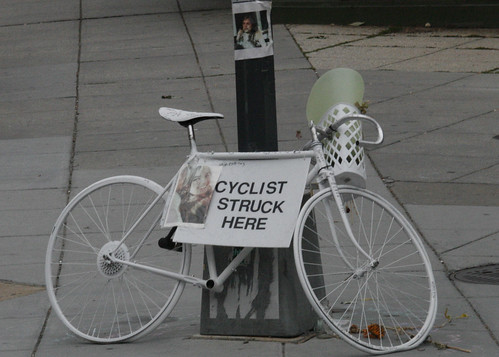We read the comments section so that you don’t have to.
I loved this comment on Chris’s recent streetsblog piece, so I am posting it here in its entirety. I suspect that this welcome attitude from a motorist is more common than not:
taomom: A few years ago, before I started bicycling in the city, I was blocked by a Critical Mass making its way down Valencia Street. Once I realized what it was and that I was not likely to cross Valencia for a while, I sat there watching the parade pass by. It was somewhat annoying to be delayed five minutes, but it was also mildly entertaining. No one was rude to me or cast any aspersions on my car.
A decade ago, I also had my way blocked for ten minutes by a biker (motorcycle, this time) funeral proceeding down Dolores Street. Again, once I realized I really wasn’t going to get across Dolores, no way, no how, I sat back and watched more ZZ Top beards pass me by than I knew existed on the planet. I chalked it up to an “only in San Francisco” experience, just like I chalk up a posse of roller bladers wearing full body purple speeding skating suits and wings on their backs making their way down the middle of Castro Street.
This is San Francisco. From time to time I am inconvenienced by parades, peace marches, demonstrations, marathons and other road runs, by neighborhood block parties, by monster rock concerts in the GG Park, and by every ethnic/cultural festival anyone can think to put on. (Once I got delayed twenty minutes by stupidly going near Japantown during Cherry Blossom festival.) I am massively inconvenienced twice a year by the street fairs in the Castro because these fairs totally screw up traffic flow and bottle up my neighborhood. But I don’t get upset because I also get a lot of benefits by living near the Castro. It’s part of the deal. (Halloween in the Castro was especially a nightmare for my neighborhood and has thankfully calmed down.) Bay to Breakers is an event so massive and disruptive, everyone in the entire city either participates or goes out of their way to steer clear. Even though I haven’t participated in Bay to Breakers in twenty years, I still find value in it and don’t begrudge the runners their use of the city.
All these events are disruptive, annoying if they delay you, but to me are part of what makes this place a creative, interesting place to live. In addition, San Francisco’s development of a bicycle culture is part of what will enable the continued economic viability of the city in the decade to come. If/when bicycles become so ordinary and mainstream that people use them like they use their vacuum cleaner (to use the Copenhagenize comparison) there will be no more Critical Masses. (Though there may still be a few bicycle parades. . .)
I concur with the suggestions for Critical Mass to take more coherent routes through the city and to sometimes take routes that aren’t so disruptive to car traffic. I also can’t deny that it would be helpful if Critical Mass participants went out of their way to be civil and courteous, because really, that is the way people should behave in general. (People also shouldn’t litter! They shouldn’t drive while talking on their cell phones! And they should pick up after their dogs!!!) But I don’t expect young people in their twenties to be entirely without impromptu, anarchistic impulses. I am very conscious that San Francisco gets a lot of benefit out of that energy.
This note from a supporter of Chicago’s Critical Mass claims that city’s ride has also led to a rise in bike activism:
Eric: As someone who helped bring Critical Mass to a major American city I am eternally grateful to the SF folks who got his, ahem, rolling. I know there is debate about whether or not SFCM has been good for bike advocacy and culture in SF and I’m not from here so I won’t speak to that. In Chicago, the results of CM are undeniable. Chicago now has a couple generations of young urban planners and traffic engineers who grew up in the CM-inspired bike culture of Chicago and the City is radically different and better as a result. Ultimately that merely is a happy side effect. The real value of CM is in the enjoyment and experience of riding a bicycle on your city’s streets without feeling your life is constantly in jeapordy, for however brief a period of time, once a month. To the naysayers, I am sorry but that is an experience that transit riders, motorists and most of the time pedestrians are granted on a daily basis. Bicycles are the only users of the public right of way who frequently use streets not designed for them. But perhaps more importantly Critical Mass has a message for people that goes beyond civil rights or transportation advocacy. It’s a message of surprise, intrigue, uncertainty, negotiation of public space and unexpected celebration. I am deeply grateful for the monthly reminder Critical Mass provides: that public space is not for the profiteering of oil and car companies but rather for public use and ENJOYMENT. I’m glad that message doesn’t fit in someone’s narrow definition of “appropriate”! Isn’t life dull enough already without turning the joyful movement from place to place into yet another rote exercise in rule obeying?


Streetsblog comments
December 22nd, 2009 by hughillustrationWe read the comments section so that you don’t have to.
I loved this comment on Chris’s recent streetsblog piece, so I am posting it here in its entirety. I suspect that this welcome attitude from a motorist is more common than not:
This note from a supporter of Chicago’s Critical Mass claims that city’s ride has also led to a rise in bike activism:
Tags: comments, motorists, streetsblog
Comments Off on Streetsblog comments